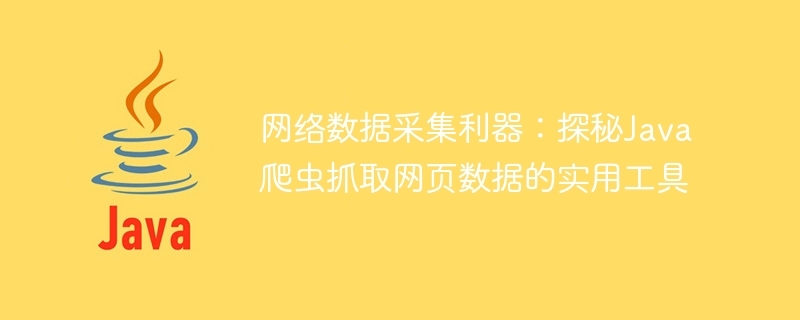

Network data collection tool: Explore the practical tool for Java crawlers to capture web page data
Introduction: With the development of the Internet, massive amounts of data are continuously generated and updated. Collecting and processing this data has become a need for many companies and individuals. In order to meet this demand, crawler technology came into being. This article will explore practical tools for crawling web page data in the Java language, with specific code examples.
Introduction to crawler technology
Crawler technology refers to the use of programs to automatically access and analyze network data to obtain the required information. In the Java field, commonly used crawler implementation methods include the use of three tools: HttpURLConnection, Jsoup and HttpClient. The following describes how to use these three tools.
The following is a sample code that uses HttpURLConnection to implement a simple crawler function:
import java.io.BufferedReader;
import java.io.IOException;
import java.io.InputStreamReader;
import java.net.HttpURLConnection;
import java.net.URL;
public class HttpURLConnectionExample {
public static void main(String[] args) throws IOException {
// 设置需要爬取的URL
String url = "http://example.com";
// 创建URL对象
URL obj = new URL(url);
// 打开连接
HttpURLConnection con = (HttpURLConnection) obj.openConnection();
// 获取响应码
int responseCode = con.getResponseCode();
System.out.println("Response Code: " + responseCode);
// 创建BufferedReader对象,读取网页内容
BufferedReader in = new BufferedReader(new InputStreamReader(con.getInputStream()));
String inputLine;
StringBuilder content = new StringBuilder();
while ((inputLine = in.readLine()) != null) {
content.append(inputLine);
}
in.close();
// 输出网页内容
System.out.println(content);
}
}The following is a sample code that uses Jsoup to implement the crawler function:
import org.jsoup.Jsoup;
import org.jsoup.nodes.Document;
import org.jsoup.nodes.Element;
import org.jsoup.select.Elements;
import java.io.IOException;
public class JsoupExample {
public static void main(String[] args) throws IOException {
// 设置需要爬取的URL
String url = "http://example.com";
// 使用Jsoup连接到网页
Document doc = Jsoup.connect(url).get();
// 获取所有的a标签
Elements links = doc.getElementsByTag("a");
for (Element link : links) {
// 输出a标签的href属性值和文本内容
System.out.println("Link: " + link.attr("href") + ", Text: " + link.text());
}
}
}The following is a sample code that uses HttpClient to implement the crawler function:
import org.apache.http.HttpEntity;
import org.apache.http.HttpResponse;
import org.apache.http.client.HttpClient;
import org.apache.http.client.methods.HttpGet;
import org.apache.http.impl.client.DefaultHttpClient;
import org.apache.http.util.EntityUtils;
import java.io.IOException;
public class HttpClientExample {
public static void main(String[] args) throws IOException {
// 设置需要爬取的URL
String url = "http://example.com";
// 创建HttpClient对象
HttpClient client = new DefaultHttpClient();
// 创建HttpGet对象,设置URL
HttpGet request = new HttpGet(url);
// 发送HTTP请求
HttpResponse response = client.execute(request);
// 获取响应实体
HttpEntity entity = response.getEntity();
// 将实体转为字符串
String content = EntityUtils.toString(entity);
// 输出网页内容
System.out.println(content);
}
}Summary
This article introduces the use of HttpURLConnection, Jsoup and HttpClient three tools for crawling in Java language methods, with corresponding code examples. These tools have their own characteristics and advantages, and it is very important to choose the appropriate tool according to your needs in actual development. At the same time, we also need to pay attention to the legal and compliant use of crawler technology, abide by laws and ethics, and ensure the legality of data collection.
The above is the detailed content of Java crawler tool: Revealing the secret of network data collection, a practical tool for crawling web page data. For more information, please follow other related articles on the PHP Chinese website!
 Introduction to interface types
Introduction to interface types
 How to resize pictures in ps
How to resize pictures in ps
 What to do if postscript cannot be parsed
What to do if postscript cannot be parsed
 Win10 does not support the disk layout solution of Uefi firmware
Win10 does not support the disk layout solution of Uefi firmware
 What are the oracle wildcards?
What are the oracle wildcards?
 Detailed explanation of sprintf function usage
Detailed explanation of sprintf function usage
 What are the four big data analysis tools?
What are the four big data analysis tools?
 How to connect asp to access database
How to connect asp to access database




